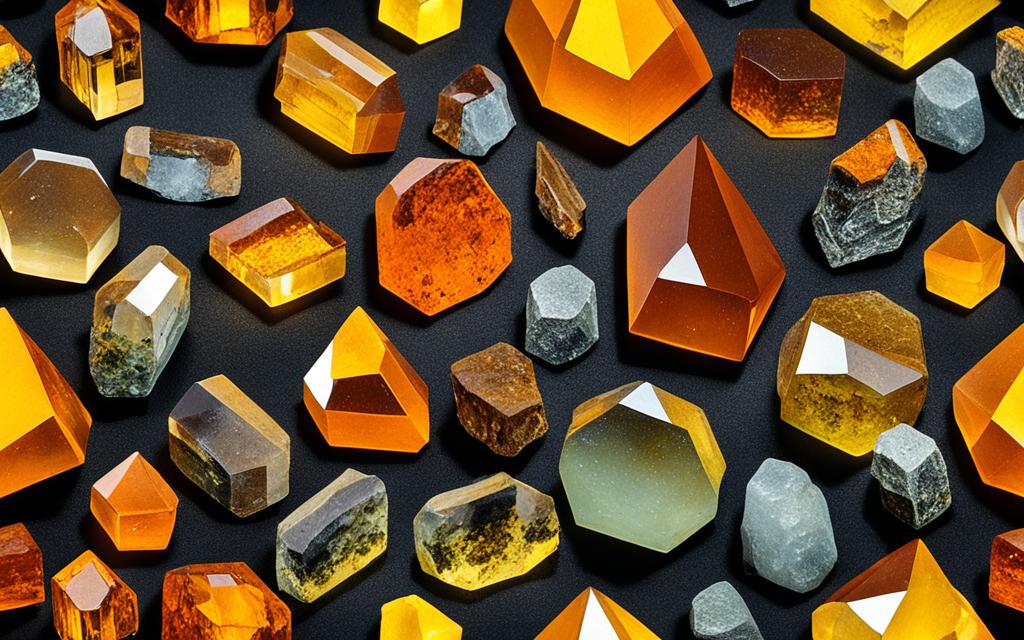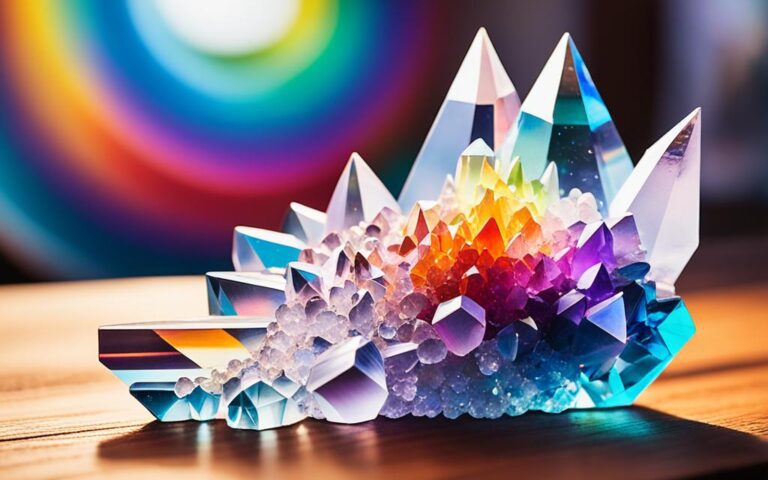Mimetite: Rare Mineral with Unique Properties
Mimetite is a gemstone that catches the eye with its bright yellow crystals and unique hexagonal shape. It’s a rare mineral in the apatite group that has won the hearts of collectors and fans around the world. Its rarity comes from being found in limited places, mainly in Namibia and China.
This mineral stands out because of its high density and how it refracts light. Only a few mimetites are cut into gemstones, making them very sought after. It also forms series with minerals like pyromorphite and vanadinite, which adds to its charm.
Key Takeaways
- Mimetite is a rare and captivating gemstone known for its vibrant yellow crystals and distinctive hexagonal structure.
- This mineral belongs to the apatite group and has a limited global distribution, with Namibia and China being the primary sources of facetable specimens.
- Mimetite’s unique properties, such as its high specific gravity and refractive indices, set it apart from more commonly encountered gemstones.
- Faceted mimetites are exceedingly rare, making them highly prized by collectors and enthusiasts.
- Mimetite forms series with other fascinating minerals like pyromorphite and vanadinite, further adding to its allure.
What is Mimetite?
Definition and Description
Mimetite is a rare mineral with the chemical formula Pb5(AsO4)3Cl. It has a unique yellow-green color and forms small, prismatic crystals. The name “mimetite” comes from the Greek word “mimētēs,” meaning “imitator.” This is because its crystals often look like those of other minerals, like pyromorphite, in the apatite group.
Origin of the Name
In 1832, French mineralogist F.S. Beaudant named mimetite. He chose the name from the Greek word “mimētēs,” meaning “imitator.” This refers to the mineral’s ability to mimic other lead minerals. This trait makes mimetite stand out among nature’s minerals.
Mimetite is a rare and captivating mineral. Its bright color, unique structure, and interesting origins make it a prized find for collectors and researchers.
| Property | Value |
|---|---|
| Specific Gravity | 7.1 – 7.24 |
| Mohs Hardness | 3.5 – 4 |
| Crystal System | Hexagonal – Dipyramidal |
| Typical Crystal Form | Short Hexagonal Crystals |
| Common Locations | Gila County, Arizona, US; Tsumeb, Namibia; Broken Hill, Australia |
Historical Background and Discovery
The story of mimetite goes back to the 18th century. Johan Gottschalk Wallerius, a Swedish chemist, documented it in 1748. He described it after studying samples from Saxony, Germany. Later, French chemists Joseph-Louis Proust and Antoine François Fourcroy also talked about it. They called it “Plomb vert arsenical” or “green lead arsenate.”
In 1832, French mineralogist François Sulpice Beudant named it “mimetite.” He chose the name from the Greek word “mimētēs” because it looks like another mineral, pyromorphite. The big find of 18th century mimetite was in the late 1800s. This was at the Tsumeb mine in Tsumeb Namibia, where many rare mimetite specimens were found.
“Mimetite is a rare and fascinating mineral with a long and storied history of discovery and exploration.”
Even though it’s rare, the discovery of mimetite has always interested mineralogists and collectors. This has led to a better understanding of this unique mineral and its different forms.
Physical Characteristics
Mimetite is a mineral that catches the eye with its unique looks and structure. It has a wide range of colors and a special crystal shape. This makes it a favorite among mineral experts and collectors.
Appearance and Color Variations
Mimetite often appears as small, prismatic crystals with a hexagonal shape. It can be many colors like yellow, orange, brown, and green. These colors come from impurities in the crystal.
Crystal Structure and Formation
Mimetite forms when minerals like arsenopyrite and galena oxidize. This process creates its unique crystal structure. It’s a secondary mineral, meaning it comes from the oxidation of other minerals.
Common Locations and Mining Areas
Tsumeb in Namibia is famous for its beautiful yellow mimetite crystals. Guangdong Province in China also has some nice pieces. Other places to find mimetite include Chihuahua and Mapimi in Mexico, and Cornwall and Cumberland in the UK.
| Locality | Mimetite Description | Size Range | Price Range |
|---|---|---|---|
| Tsumeb, Namibia | Finest yellow, transparent crystals | 0.7″ x 1.6″ x 2.5″ to 4.8″ x 3.0″ x 12.2″ | $17.50 to $140.00 |
| Guangdong Province, China | Limited quantities of facetable material | 7 grams to 479 grams | $17.50 to $140.00 |
| Chihuahua and Mapimi, Mexico | Diverse color variations and crystal forms | Less than 1/4 inch long to 3 mm in length | $17.50 to $140.00 |
| Cornwall and Cumberland, United Kingdom | Unique crystal formations and color banding | 0.7″ x 1.6″ x 2.5″ to 4.8″ x 3.0″ x 12.2″ | $17.50 to $140.00 |
Mimetite’s unique colors and crystal structure make it a prized mineral. Collectors and enthusiasts around the world seek it out.
Different Types
Mimetite is a rare mineral that comes in many beautiful types. These types often have unique colors or shapes because of impurities. Each type has its own special beauty.
Bellite
Bellite is a type of mimetite that has a bright red, yellow, or orange color. This color comes from chromium in the mineral.
Campylite
Campylite is another type of mimetite known for its barrel-shaped crystals. It is mainly found in France and England, making it interesting to collectors worldwide.
Prixite
Prixite is a special type of mimetite from France. It is a lead arsenate with water in it.
Color-Banded Mimetite
Recently, a new type of mimetite was found. It has bands of color that look like “wood tin” and other minerals. This type comes from Bolivia.
These mimetite types show how diverse the mineral can be. They have different colors, shapes, and places they come from. This makes them very interesting for collectors and fans.
Scientific Properties
Mimetite is a rare and fascinating mineral. It has a complex chemical makeup and unique properties. Its formula includes lead, arsenic, chlorine, and oxygen. It also has impurities like calcium, fluorine, chromium, and vanadium.
Chemical Composition
Mimetite’s chemical makeup is quite unique. Lead makes up 69.61% of it, arsenic 15.10%, chlorine 2.38%, and oxygen 12.90%. These elements together give mimetite its special traits.
Mohs Hardness Scale Rating
On the Mohs hardness scale, mimetite scores between 3.5 and 4. This means it’s a soft mineral. It can easily be scratched or damaged. So, it needs to be handled with care.
Crystal System and Habit
Mimetite crystallizes in the hexagonal system. It often forms prismatic or needle-like crystals. This unique shape makes it visually striking and distinct.
Optical Properties
Optically, mimetite stands out with a high refractive index of 2.128 to 2.147. It’s also piezoelectric, meaning it can create an electric charge when pressed.
Mimetite’s mix of chemical makeup, hardness, crystal structure, and optical properties makes it a standout mineral. It’s highly valued by collectors and enthusiasts.
Mimetite
Mimetite is a mineral that has always caught the eye of gemologists, collectors, and researchers. Its bright colors, unique crystal shapes, and interesting scientific traits make it a favorite in the mineral world.
This mineral is known for its chemical makeup, which links it to other minerals like pyromorphite and vanadinite. This connection gives mimetite its wide range of mimetite properties and mimetite characteristics. It’s a mineral that stands out for its many features.
| Property | Value |
|---|---|
| Chemical Formula | Pb5(AsO4)3Cl |
| Mohs Hardness | 3.5 – 4 |
| Crystal System | Hexagonal, Dipyramidal |
| Symmetry | 6/m |
| Notable Occurrences | Mapimi, Durango, Mexico; Arizona lead mines; Tsumeb, Africa |
Mimetite is also celebrated for its physical characteristics, like its bright colors and unique crystals. These traits have made it a top choice for collectors and enthusiasts. Specimens from places like the Ojuela Mine in Mapimi, Durango, Mexico, are highly valued.
Mimetite’s allure and scientific importance mean it will keep captivating and intriguing people for a long time. Researchers and enthusiasts will continue to explore its mimetite properties and mimetite characteristics.
Identifying Mimetites
Identifying mimetite can be tough because it looks similar to other minerals like cassiterite, wulfenite, and vanadinite. Yet, there are key features that set it apart.
Mimetite is very dense, with a range of 7.24 to lower if calcium replaces lead. Its colors, such as yellow, red, orange, brown, white, and sometimes green, help identify it. Most mimetites are translucent to opaque, but transparent ones are very rare.
The way mimetite forms crystals, like botryoidal or hexagonal prismatic, is another clue. It also has piezoelectric properties, meaning it creates an electric charge when pressed.
Its refractive index, between 2.128 and 2.147, and Mohs hardness of 3.5-4 are also useful for identification. But, these can be similar to other minerals, so more analysis is needed.
Pyromorphite, a mineral similar to mimetite, can be hard to tell apart. Advanced chemical tests are often needed to distinguish them.
| Characteristic | Mimetite | Other Rare Gems |
|---|---|---|
| Density | 7.24 (can be lower with calcium replacement) | Varies depending on the mineral |
| Colors | Yellow, red, orange, brown, white, rarely green | Varies by mineral type |
| Transparency | Commonly translucent to opaque, rarely transparent | Varies by mineral type |
| Crystal Habit | Botryoidal, hexagonal prismatic, radiating prisms, aggregates | Varies by mineral type |
| Refractive Index | 2.128 – 2.147 | Varies by mineral type |
| Mohs Hardness | 3.5 – 4 | Varies by mineral type |
By looking at these unique features and doing advanced chemical tests when needed, experts can spot mimetite. They can tell it apart from other rare gemstones that look similar.
Is There Synthetic Mimetite?
Scientists have made synthetic mimetite in the lab for research. This synthetic mimetite has a special mix of elements like P2O5, As2O5, PbO, and Cl. It also has a specific crystal structure.
They made mimetite to study its uses, like cleaning arsenic from polluted areas. But, synthetic mimetite isn’t used in jewelry or gemstones yet. All mimetite used for decoration comes from nature.
There are no treatments to make mimetite look better. Its bright colors and unique shapes come from nature. This makes it special.
So, synthetic mimetite is made for research, not for jewelry. Its natural beauty and rarity make it popular among collectors of rare minerals.
Where is Mimetite Found?
Mimetite is a rare and fascinating mineral found in many places worldwide. Tsumeb, Namibia, is famous for its large, clear yellow mimetite crystals. These crystals can grow up to an inch long. Recently, China’s Guangdong Province has also found mimetite, adding to its global presence.
In Mexico, Chihuahua and Mapimi are known for their mimetite. Here, you can find orange and yellow globular masses. Most mimetite is kept as a mineral, but some small pieces are turned into gemstones. These gemstones usually weigh a few carats, with the biggest being around 5-7 carats.
Stone Sizes
Mimetite crystals vary in size, from tiny to over an inch long. This size range means collectors can find both large samples and small crystals to turn into gemstones.
| Mimetite Mining Locations | Mimetite Stone Sizes | Mimetite Color Variations |
|---|---|---|
| Tsumeb, Namibia | Up to 1 inch in length | Transparent yellow |
| Guangdong Province, China | Facetable material | Limited quantity |
| Chihuahua and Mapimi, Mexico | Globular masses | Shades of orange and yellow |
| Worldwide | Millimetric to centimetric | Yellow, orange, burnt orange, green |
“Mimetite, a rare and intriguing mineral, has been discovered in numerous localities around the world.”
How to Care for Mimetite Gemstones
Mimetite gemstones are special and need gentle care to stay beautiful. It’s important to clean and store them right to keep them in top shape.
Cleaning Mimetite Gemstones
When cleaning mimetite, stay away from harsh chemicals or rough surfaces. Use a soft brush, mild soap, and lukewarm water to clean off dirt. Don’t keep the gemstone in water too long because it’s a bit soft.
Storing Mimetite Gemstones
Storing mimetite right is crucial. These minerals don’t like extreme heat or humidity, which can harm them. Keep them in a cool, dry spot, away from sunlight. Wrap each piece in a soft cloth to protect it from scratches.
By following these easy tips for mimetite gemstone care, mimetite cleaning, and mimetite maintenance, your mimetite jewelry or collections will stay beautiful for a long time.
“Mimetite is a rare and fascinating mineral that requires delicate handling to maintain its beauty. With the right care, these unique gemstones can be enjoyed for generations to come.”
Metaphysical and Healing Properties
The rare mineral mimetite is a gemstone with deep spiritual and healing powers. It’s mostly yellow and linked to joy, hope, and focus. This makes it great for balancing the solar plexus chakra.
Spiritual Significance and Symbolism
Mimetite helps with being open, feeling stable, and cleaning the aura. It’s also a symbol of bravery and strength. This helps people face tough times with clear thoughts and strong will.
Healing Properties and Benefits
Mimetite is known for balancing feelings, bringing peace, making one more open, and cleaning the energy field. It’s good for those going through big changes or wanting energy for their passions.
Emotional Properties
- Mimetite opens the third eye and crown chakras, helping with clear thinking, change, and spiritual growth.
- This crystal draws luck, wealth, and helps with making dreams come true. It’s great for those wanting to grow personally and financially.
- Mimetite is especially good for Pisces, Aries, and Leo. It grounds energy, gets rid of bad feelings, and boosts confidence.
Mimetite is a fascinating gemstone with many spiritual and emotional benefits. It can help those who use it in their lives.
Mimetite Value
Mimetite is a rare and fascinating mineral. It is highly valued by collectors and enthusiasts. Because it is scarce, cut and polished mimetite crystals are very expensive.
The most valuable mimetite gemstones have bright, pure colors and are clear. They also have few inclusions. Crystals from Mexico can be up to 1-2 inches long. Those from Tsumeb, Namibia, and Guangdong, China are very rare and often kept as they are.
The limited supply of mimetite gemstone value makes it very sought after. Mimetite rarity greatly affects its price. The mimetite price varies a lot based on quality and origin.
“Transparent mimetite crystals suitable for faceting are extremely rare, making them highly prized by collectors.”
Mimetite is not very hard, with a Mohs hardness of 3.5-4. But its unique properties and beautiful colors make it popular. It is found in many places, including Namibia, China, Mexico, and others. This makes it even more valuable.
In conclusion, mimetite’s value comes from its rarity, especially for clear and cut specimens. Its unique features, limited supply, and global distribution make it a top choice for collectors. This is why it has a high mimetite price.
Conclusion
Mimetite is a truly remarkable mineral that grabs the interest of many. It has vibrant colors and unique crystal shapes. These features, along with its scientific properties and possible metaphysical benefits, make it special.
As more discoveries are made, mimetite’s significance will likely grow. It will become even more valuable and sought after. This mineral is a unique treasure in the natural world.
The summary of mimetite shows it’s not just beautiful but also very important scientifically. Researchers from different fields find it fascinating. They study its complex makeup and various crystal forms.
Studies on mimetite’s stability and how it changes are important. They help us understand how to deal with heavy metal pollution and clean up contaminated areas.
Mimetite will continue to fascinate and inspire people for a long time. Its unique traits, wide range of occurrences, and potential uses make it a standout mineral. It’s worth studying and appreciating deeply.






